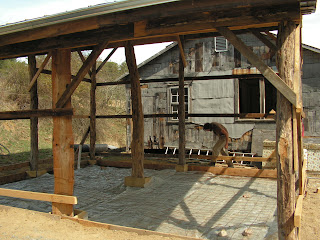
In cool nights and leafy breezes, autumn shows itself as summer spins downward, weed stalks harden and seedheads stick to cotton shorts.
There have been a number of improvements to the farm in the past 3 weeks.
First, here's a new road, cut and graveled 100 feet from Catawba Drive up to the back of the milk parlor and its addition still in the works. Below, Kevin rakes gravel for the pad of the addition-- a milk storage and processing room .

In preparation for our two calves this month, we've fenced in a calf pen of about 300 perimeter feet that includes an old barn for winter warmth. It's near the milk parlor, so we can bottle-feed the calves easily with fresh, warm milk. Separating the calves at 2 or 3 days from their mother is perhaps not the most natural or nicest thing to do, but it trains the calf to people, ensuring she'll be affectionate and sweet. Plus, the people get more milk, and the teats of their mothers are spared the blisters and bleeding from the calf's teeth--interestingly human hands are much gentler on cow's teats than calves.

Here's the farm cafe, an ongoing project to carve out a space to store people--in other words, a place for social things like sitting, talking, meeting, eating, all out-of-doors. From the demolition of an old house on the same site, right behind the milk parlor, we've laid down a stone courtyard from the house foundation stones, much them, beautiful Quartz in many quartzy hues. 'Smoky'-- hues of grey and black, orange sandy colors and the spectacular 'Rose quartz'--ranging from light pink to crimson or deep magenta. Quartz comes more often clear than it does opaqu, with lines of color and tone. When it does come opaque, I've named it 'Milky quartz'.
That's Andy sawing stakes to hold up the wood forms to contain the concrete slab of the parlor addition.

From the courtyard farm cafe, here's shot looking up into the pasture to the upper garden, prayer flags and the farm's centerpiece, the old persimmon tree, 13 inches across at breast height, pretty big for a slow-growing wild American persimmon.
Diospyros virginiana is the only specie of Ebony tree found outside the tropics. Like all ebonies, it's wood is hard and dark. Besides producing delicious fruits (
Diospyros means "food of the gods" in latin) its wood has been used to make all sorts of furniture and things like door handles. Here's a closer shot of it up on the saddle--

Looks very nice when decked with gold-ball size, orange fruits, but not this year...
Persimmons often bear fruit in alternate years like many fruiting trees. There are wonderful summer apples coming in right now, though, with a wonderful yellow-red striped skin and sweet/sour flesh, good for fresh-eating either green or striped, cooking down, and fed to cows to feel their kicking calves inside!

Here's the corn patch. We're raising an open-pollinated (true-to-type if not crossed-pollinated) heirloom type of corn called 'bloody butcher'. When it matures, e.g.- when it dries down into hard cobs & kernels, it will be ground for flour and used for next year's seed, unlike 'sweet corn' that is eaten wet or sweet & immature. Last week, Andy cut the tassels off the tops, taking much height off the crop in a bid to prevent 'lodging', when the corn topples over from hard winds and rains, and regrettably from raccoons or bears. This garden is in a bit of a wet spot, near a perennial springbed, not great for preventing lodging in corn. Andy reports that there's at least 40 pumpkins in there amongst the stalks, since he placed a board under each one to prevent rot. Gobs of beans, too.

<-- The single best improvement to the farm in recent weeks! An old chalkboard now built into the milk parlor wall, with the function of organizing the work week, planning, and sharing news. Andy, Geoffrey, and Kevin's daily schedule is written in there, with Important Neighborhood Numbers (phone #'s), who prepares Lunch and Dinner, and so on...

Here's a nice thing: about 160 blueberry bushes, 250 apples, a bundle of pecan and chestnut trees. Part of the Raven Ridge Nursery stock
tbp ('to be planted' or maybe 'to be purchased' -- would you like on for your homestead?) But seriously, the promise of perennial trees and vines bearing fruits and nuts years from now is positively divine! I am very happy that these trees were saved from the virulent pigweeds and crabgrasses infesting their pots and will find a nice home on the farm or in your backyard.
 all for now
all for now




























 all for now
all for now





